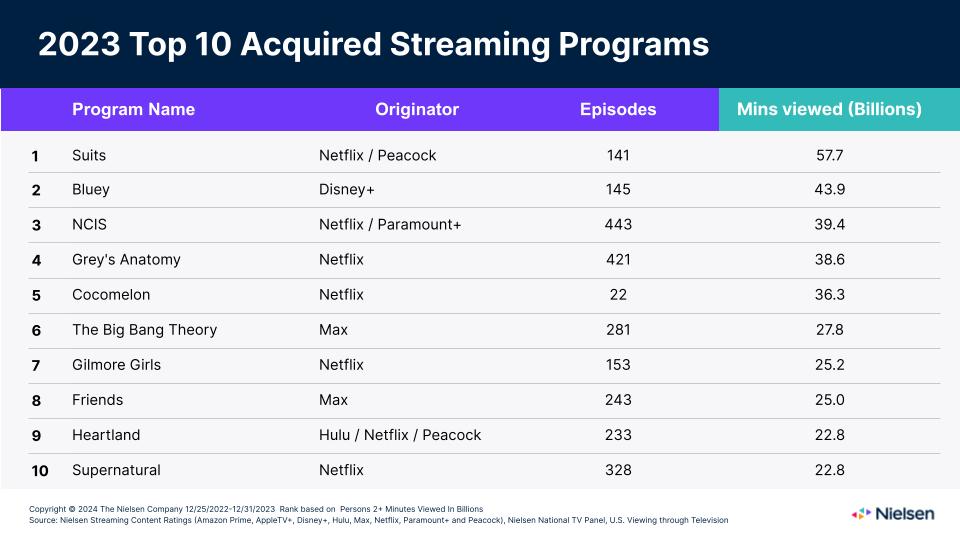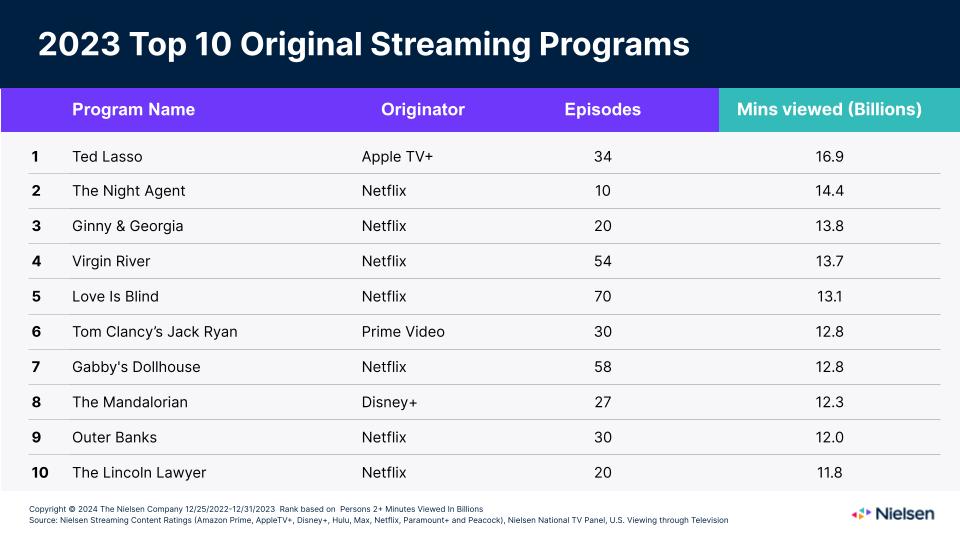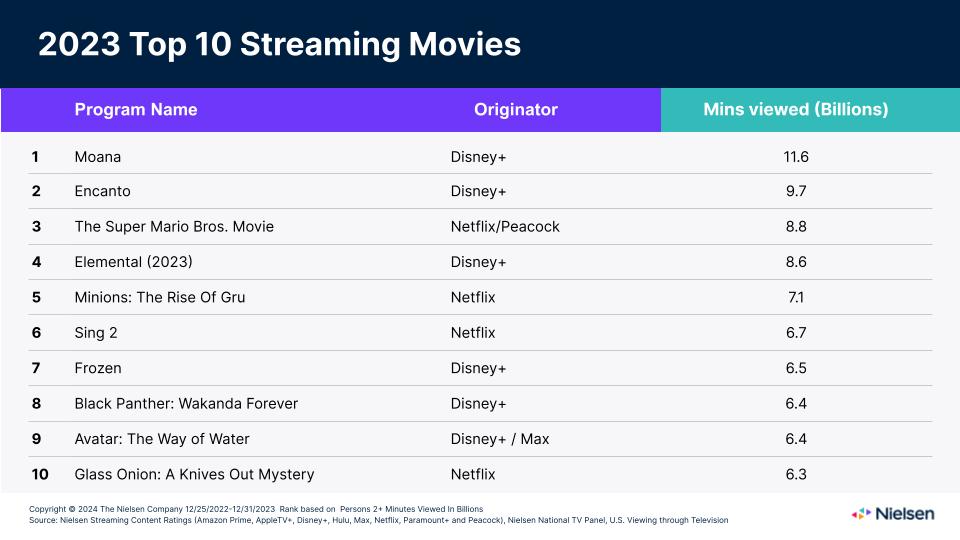Americans streamed 21 million years’ worth of content last year
The growing bounty of content on streaming services has forever changed TV viewing behavior, with streaming consumption now consistently accounting for the biggest driver of TV usage1. And while the time we spend with TV is largely flat, our time spent streaming video continues to rise. In 2023, U.S. audiences streamed 21 million years’ worth of video, an incredible 21% increase from the 17 million years worth2 they streamed in 2022.
Compared with 2022, however, the writer and actor strikes in Hollywood meant that audiences had significantly less new content to binge throughout much of 2023. That, combined with a focus on content monetization across the streaming landscape, helped inspire new content distribution strategies to keep audiences engaged and loyal amid the range of new service offerings. According to Gracenote, audiences had 90 different streaming services to choose from at the end of last year, up from 51 at the start of 2020.
The depth of those services—just under 1 million unique titles worth3—proved vital in 2023, with existing library content becoming instrumental as services carefully rationed the stockpiled originals they had in their arsenals. The environment also inspired new perspectives about content licensing, as titles that were once exclusive to individual platforms began appearing on multiple services—a significant pivot from previous years. Band of Brothers and The Pacific, for example, benefited as a result of this approach, appearing on Nielsen’s U.S. top 10 list the week of Sept. 18, 2023, given their availability on both Max and Netflix.
Diving deeper into streaming viewership trends in 2023, there was no clearer beneficiary of this shift than Suits, which spent a 12-week run in the No. 1 spot on Nielsen’s U.S. top 10 list as a result of its availability on Netflix and Peacock. In total, the program, which originally aired on USA Network from 2011 to 2019, racked up 57.7 billion viewing minutes in 2023—enough to take the crown away from another audience favorite, The Office, which generated 57.1 billion viewing minutes in 2020 amid pandemic-induced lockdowns. NCIS is the other stand-out example of a show with an entirely new life outside of linear TV, landing in the third spot on the acquired list for the year. With its availability on both Netflix and Paramount+, NCIS gained 1.3 million viewing minutes from last year to end 2023 with 39.4 billion minutes.
Unlike the many live-action shows that were affected by the strikes of 2023, an abundance of animation series were not, including Bluey and Cocomelon, which closed the year in the second and fifth spots. Engagement with Bluey, which doubled its viewing time from 2022 to 43.9 billion viewing minutes, was strong enough for it to overtake Cocomelon, which was the top program for kids in 2021 and 2022.

Despite the presence of the writer and actor strikes last year, a handful of originals did come to market, and the U.S. top 10 titles garnered more than 133 billion minutes viewed. The biggest surprise in the list, however, was Ted Lasso, the signature series of Apple TV+ that took the crown as most-watched original program despite the fact that the platform has a smaller relative footprint than the other platforms. Service footprint size notwithstanding, the series benefited from two notable dynamics:
- The buildup to the (assumed) final season
- A progressive lengthening of each episode from 30 minutes in the first season to 45 minutes in season two to 60 minutes in season three, capped by a 76-minute finale.

In the movie category, two highlights stand out among streaming trends:
- Moana, released on Disney+ in late 2019, continues to engage audiences, topping all other movies in 2023 with an all-time high of 11.6 billion viewing minutes after landing in the top four spots over the past four years. Since Nielsen began measuring streaming, audiences have watched nearly 80 billion minutes of Moana, which translates to watching the full movie 775 million times.
- Originally released in 2021, Encanto’s appeal with audiences also continued into 2023 with just under 10 billion viewing minutes after topping the movie list in 2022 with 27.4 billion viewing minutes.

Looking to the year ahead, industry sentiment suggests that, even with the Hollywood strikes behind us, audiences will continue to see less new content than we saw in 2022—the likely high water mark for scripted programming. Given the massive library of existing video titles—more than 1.1 million across linear and streaming—combined with evolving distribution strategies, audiences will never find themselves with nothing to watch. That said, however, streaming will remain a dominant option in the U.S., especially as high-profile sporting events, like the recent NFL playoff game between Kansas City Chiefs vs. Miami Dolphins (which attracted 22.8 million live and same day viewers4), become exclusive to streaming services.
Amid the ongoing excitement about streaming, however, it’s important to note that streaming is no longer limited to on-demand programming. The rise of virtual multichannel video programming distributors (vMVPDs), free advertising-supported streaming television (FAST) channels and apps that offer access to live programming highlights the continued blurring between linear and streaming TV. For example, more than 80% of houses that access TV content from an internet connection watched some form of linear programming in 2023. The takeaway here is that the TV screen remains the biggest device for media engagement, but it’s now a conduit for all content rather than a screen for channel-specific programming.
Want more insights into the time viewers spend watching streaming video content? Check out Nielsen’s Streaming Content Ratings.
Sources
- The Gauge: Streaming usage accounted for more than one-third of total TV usage in February 2023 and has remained above 35% since May 2023.
- Excludes linear streaming (live television viewed through apps).
- Gracenote Global Video Data; October 2023.
- Nielsen National TV Panel.



